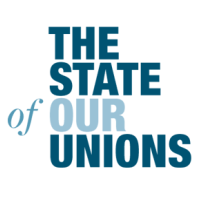Unions Decline Most Everywhere in U.S. Except California

UC Berkeley professor Harley Shaiken, upon seeing the latest report on union membership from the U.S. Bureau of Labor Statistics, told the Los Angeles Times last week that “reports of labor's death have been greatly exaggerated.”
But other than a faint pulse in California and similar signs of life in 13 other states, organized labor continued to show a stead decline in health. In 2012, union membership nationally hit its lowest mark, 11.3% of the workforce, since Franklin Delano Roosevelt was president in 1936. Those numbers rise slightly when you add workers who are represented by unions but aren’t members. The high watermark for union membership was 28.3% in 1954.
California union membership was up a tiny 0.1%, to 17.2, but because of the state’s size it contributed by far the most new union workers in the country. The state added 110,000 new union members, while membership declined 400,000 nationally. Texas added 65,000 with a 0.5% uptick, but Texas has the 12th lowest percentage of union workers to start with. California has the 6th highest.
Californians have the most union members in the country, 2.5 million out of 14.4 million nationally. About half of the country’s union members live in just seven states, including New York (1.8 million), Illinois (0.8 million) and Pennsylvania (0.7 million). Michigan, New Jersey and Ohio each have 0.6 million.
The trend downward in union membership has extended across economic good times and bad. Globalization, the decline of manufacturing, state and national politics, ideology and changed public perceptions have all contributed to a steady erosion in union membership as well evisceration of the middle class.
The steady decline nationally was briefly stalled during the rise of service sector unions representing lower wage earners. But a string of Republican statehouse victories against the unions’ longtime allies in the Democratic Party have led to major assaults on unions.
Michigan and Indiana both became “right-to-work” states last year, bringing to 24 the number of states where unions can't collect dues as a condition of employment. Most “right-to-work” states, dubbed by their critics “right-to-work-for-less” states, are in the South and West, but the Midwest has become a battleground of late.
California voters rejected an attempt to hamstring unions’ ability to collect and disburse political money when they defeated Proposition 32 at the polls last November, 56-44.
–Ken Broder
To Learn More:
Union Members Summary (U.S. Department of Labor Bureau of Labor Statistics)
California Unions Grow, Bucking U.S. Trend (by Alana Semuels, Los Angeles Times)
Union Membership Falls to Lowest Percentage in 76 Years (by James B. Kelleher, Lisa Lambert and Bernie Woodall, Reuters)
What Can Obama Do for the Labor Movement? (by John Cassidy, The New Yorker)
- Top Stories
- Controversies
- Where is the Money Going?
- California and the Nation
- Appointments and Resignations
- Unusual News
- Latest News
- California Forbids U.S. Immigration Agents from Pretending to be Police
- California Lawmakers Urged to Strip “Self-Dealing” Tax Board of Its Duties
- Big Oil’s Grip on California
- Santa Cruz Police See Homeland Security Betrayal in Use of Gang Roundup as Cover for Immigration Raid
- Oil Companies Face Deadline to Stop Polluting California Groundwater





